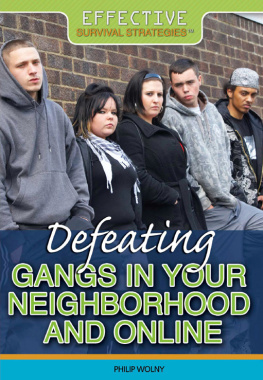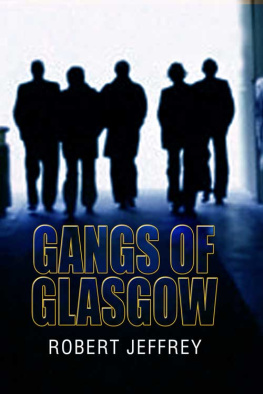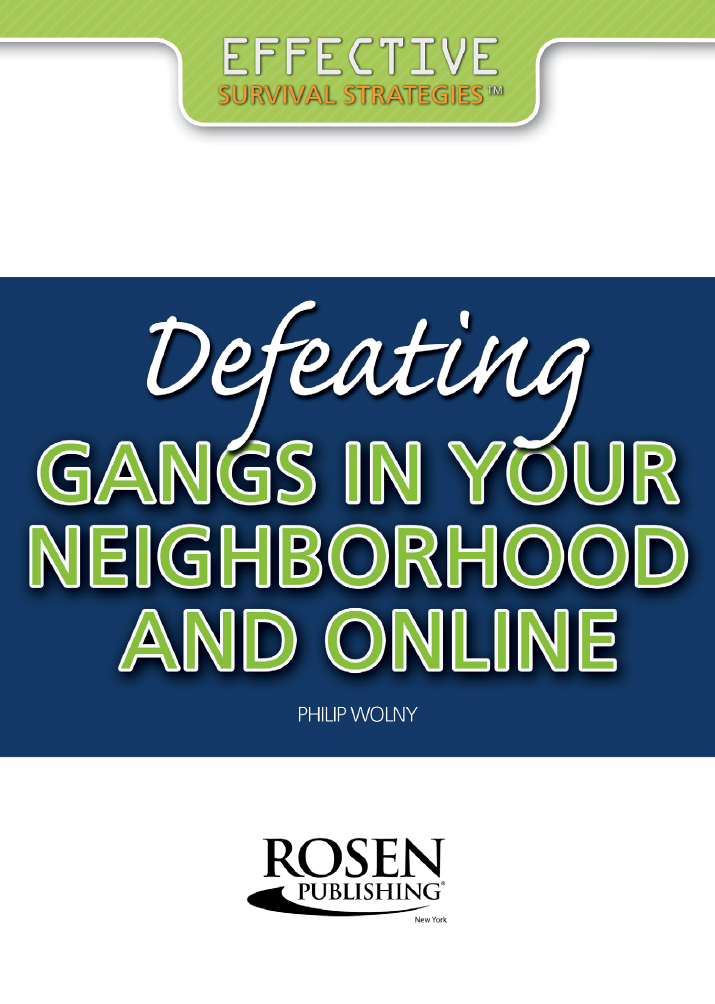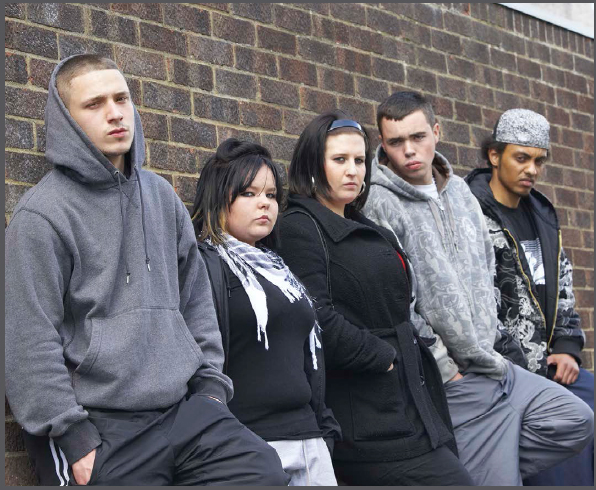Published in 2016 by The Rosen Publishing Group, Inc.
29 East 21st Street, New York, NY 10010
Copyright 2016 by The Rosen Publishing Group, Inc.
First Edition
All rights reserved. No part of this book may be reproduced in any form without permission in writing from the
publisher, except by a reviewer.
Library of Congress Cataloging in Publication Data
Wolny, Philip.
Defeating Gangs In Your Neighborhood And Online / Philip Wolny. -- First edition.
pages cm. -- (Effective survival strategies)
Includes bibliographical references and index.
ISBN 978-1-4994-6151-0 (library bound)
1. Gangs--United States--Juvenile literature. 2. Gang members--United States--Juvenile literature. 3. Juvenile delinquency--United States--Prevention--Juvenile literature. I. Title.
HV6439.U5W66 2016
364.10660973--dc23
2015022418
For many of the images in this book, the people photographed are models. The depictions do not imply actual situations or events.
Manufactured in China
Contents
INTRODUCTION
CHAPTER 1
WHAT ARE GANGS?
CHAPTER 2
GANGS AROUND YOU
CHAPTER 3
HOW TO AVOID AND DEAL WITH GANGS
CHAPTER 4
GANGS: SOLUTIONS ON THE GROUND
CHAPTER 5
FIGHTING BACK AND THRIVING ONLINE AND OFF
GLOSSARY
FOR MORE INFORMATION
FOR FURTHER READING
BIBLIOGRAPHY
INDEX
Introduction
D uring the July 4th weekend in 2014, in Chicago, Illinois, there were eighty-two shootings. Fourteen of these were fatal. While violent and major crimes of all kinds have been on a decline in cities in recent years, Chicago, the third-largest city in the United States, has instead suffered an epidemic of gang violence, fueled by a boom in the illegal heroin trade. The number of violent incidents and gang-related murders has risen steadily in the past ten years and has renewed the citys reputation as a gang mecca.
Chicago is not alone. Many U.S. cities have troubling gang problems, including ones whose crime rates have otherwise declined, such as New York City. Some gang trouble spots include St. Louis, Missouri; Memphis, Tennessee; Oakland, California; and dozens of other mid-sized and large urban areas.
As U.S. News reported in March 2015, gangs are on the rise in the United States, even as overall violent crimes are reported to be decreasing. Senior researcher James Howell of the National Gang Center told U.S. News that, nationally, in the past five years, there has been an 8 percent increase in the number of gangs, an 11 percent increase in members, and a 23 percent increase in gang-related homicides. He added that gangs were responsible for 16 percent of all killings and about a quarter of all homicides in cities with more than 100,000 people.
Gangs remain an unwelcome presence everywhere. They are known for problems ranging from minor juvenile delinquency to serious crimes like grand theft, drug trafficking, prostitution, and murder.
Street gangs remain a problem for youth and society at large, and not just in big cities. Middle-class suburbs and rural regions are also at risk. As living in big cities has become more expensive, poorer populations and people who have immigrated to the United States have been moving to the suburbs. Gangs have followed them and even spread to middle-class areas.
Gangs presence online has expanded their reach. They now recruit for and promote their organizations, threaten each other and innocent bystanders, and organize their activities with a click on a smartphone or computer. Police have capitalized on this social media presence, but gang activity flies under their radar.
Ganglike activity such as bullying has also entered the Internet age. Young people now congregate online as much as they do at school or at the mall, and gangs can take their negative influence and intimidation 24-7. Cyberbullying is a widespread problem that previous generations had no experience with. Gangs can use these new tools to their advantage to pressure rivals and victims into silence.
Solutions and strategies to combat gangs exist, however, and can be found wherever concerned youth and their adult allies choose to cooperate. The Internet also offers many tools to power and amplify antigang efforts. Even just one person can make a differencewith a social network at his or her disposal, a person can connect with those who have similar ideas, and their efforts can double, even becoming unstoppable. In this resource, we will take a look at gangs and investigate ways to defeat them in your neighborhood and online.
CHAPTER 1
WHAT ARE GANGS?
W hen people speak of gangs, what do they mean, exactly? There is no exact definition of the term, and people in different areas, whether they are teenagers, adults, politicians, or law enforcement, make their own definitions.
However, for purposes of this resource, and in most of the public imagination, the term gang is short for street gang. A gangs main activities are in the street, in the community at large, at school, or in other public places. They are also different from other groups, including criminal organizations like crews of thieves, adult organized crime groups like the Mafia, prison gangs, or other outlaws, such as members of some motorcycle clubs. They also differ from organized crime groups that engage in activities such as identity theft, computer hacking, human trafficking, and other offenses. Street gangs sometimes have ties to such groups and are similar in their structures, but they are a distinct phenomenon.
While gang activity has long been identified with males, gangs in the twenty-first century have changed. Female membership in gangs has risen, and female roles in gangs have changed, too.
According to the National Gang Center, there are several characteristics of gangs. These often include the following:
A gang has three or more members.
Gangs are made up of adolescents, teenagers, and young people, usually between the ages of twelve and twenty-four.
A gang has an identity, usually tied to a name.
Gang members view each other and are recognized by outsiders as a gang.
Gangs are organized and have some permanencethat is, members stick around for a while.
Gangs take part in elevated criminal activityeverything from petty crime, including minor assaults, to more serious crimes.
Gang Members: Telltale Signs
Gang members bond and establish an identity, both among their peers and to the world at large. These can include physical symbols of gang affiliation such as clothes or tattoos, as well as actions, names, codes, and other identifiers.
The stereotype of gang members is that most are toughlooking or intimidating young men. Some gang members are tougher to spot, however. Because law enforcement has come down hard on gangs, greater secrecy and a lower profile can benefit gangs that are more interested in money than promoting fearsome reputations. Still, for most teens, financial motivations for gang activity are less important. The sense of belonging and identity are among the most important reasons. One big way of establishing identity is through personal appearance.
Gang Colors
Southern Californiabased gangs cultivated very specific clothing styles to signify their place in gang culture and to their particular gangs. One way is through similar or identical clothing or colors. The gangs of Los Angeles, such as the Bloods and Crips, for example, are identified with the colors blue and red, respectively. Gang photos often portray gang members sporting these color schemes in items such as baseball caps, bandanas, T-shirts, socks, sneakers, and other clothing and accessories. Many Latino gangs in California often adopt a simpler style, with white T-shirts, thin belts, baggy pants or shorts, and bandanas.
















